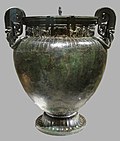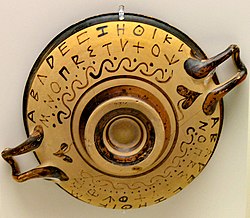Archaic Greece
Archaic Greece (800-479 BCE) is the period in Greek history after the Bronze Age collapse and before the Greco–Persian wars.[1] Their art has a more natural and realistic style.[2] Greek art was less geometric and more naturalistic. Paintings on vases had representations of human figures, most of the time with mythical tales.[3]
The Ancient Olympic Games started in the Archaic Period.
Archaic Greece Media
Ruins of the Temple of Apollo within the polis of Ancient Corinth, built c. 540 BC, with the Acrocorinth (the city's acropolis) seen in the background
The lawgiver Solon reformed the Athenian constitution, which led to significant developments in Greece
Ancient Greek colonies in the archaic period
The Temple of Concordia, Valle dei Templi, Magna Graecia, in present-day Italy
An ear of barley, symbol of wealth in the city of Metapontum in Magna Graecia (i.e. the Greek colonies of southern Italy), on a stamped stater, minted c. 530–510 BCE
The Vix Krater, an imported Greek wine-mixing bronze vessel found in the Hallstatt/La Tène grave of the "Lady of Vix", Burgundy, France, c. 500 BC
Attic black-figure vessel with double alphabet inscription, showing new letters ΥΧ[Φ]Ψ, and ΥΧΦΨΩ. Probably early 6th c. BC
Homer, author of the earliest surviving Greek literature
References
- ↑ Lloyd, James. "Greek Archaic Period". World History Encyclopedia. Retrieved 2023-01-01.
- ↑ "Greek Art in the Archaic Period | Essay". www.metmuseum.org. Retrieved 2023-01-01.
- ↑ "Archaic period | art history | Britannica". www.britannica.com. Retrieved 2023-01-01.









